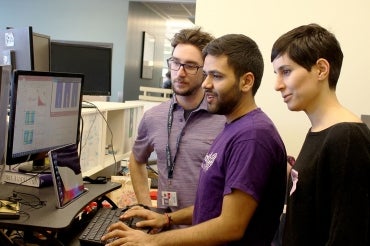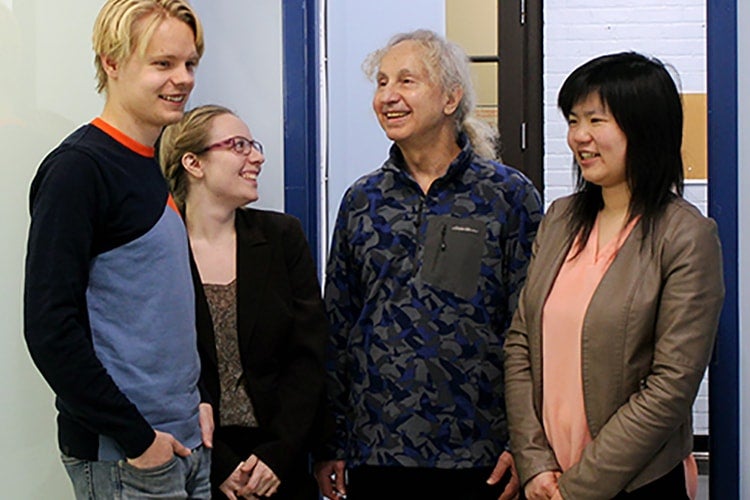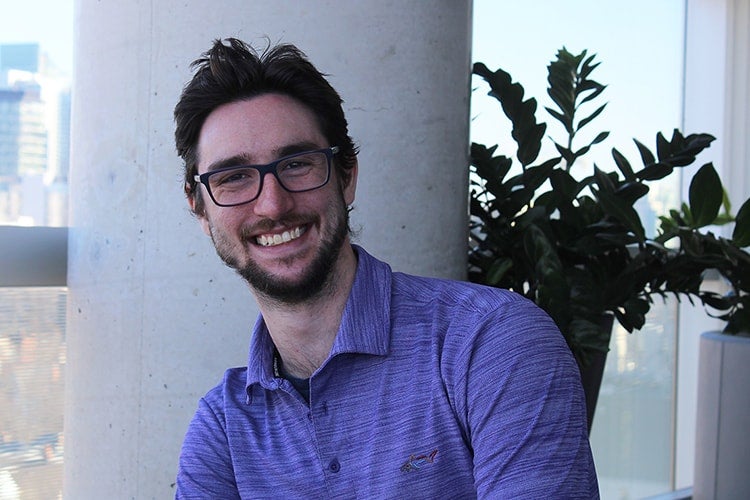Purple Day: Meet U of T students researching new ways to understand epilepsy

Published: March 26, 2018
Each day in Canada, an average of 42 people learn that they have epilepsy. The majority of new patients are young children and senior citizens.
The cause of this neurological disorder is unknown for more than half of identified cases. Long-term drug therapy is the predominant form of treatment, but does not provide a cure and can have undesirable side effects, from nausea to severe liver complications.
In recognition of Purple Day, an international grassroots effort to increase awareness about epilepsy around the world, several University of Toronto students in the Institute of Biomaterials and Biomedical Engineering (IBBME) share their research efforts to develop better treatments and improve the quality of life for individuals facing the neurological disease.
Azin Ebrahim Amini
Azin Ebrahim Amini, a master's of applied science candidate, is working with Dr. Peter Carlen, a neurologist at the Toronto Western Hospital and senior scientist at the Krembil Research Institute, to examine a known contributor of epileptic seizures in the brain. Carlen is also a professor in the department of medicine and IBBME.
“I am investigating the role of potassium concentration and how it starts and maintains seizures in the largest part of the brain,” said Ebrahim Amini.
One of her research techniques involves the use of a novel experimental platform that allows her to record neural activity and potassium concentrations simultaneously from the same location in the brain.
Her methodology combines the use of specifically manufactured electrodes to view potassium distribution over the neocortex and the exposure of green light on genetically modified glial cells, a support cell found in the nervous system. The light causes the cells to open membrane channels to take in potassium and thereby reduce its concentration in the brain. This action could have major effects on several brain processes, including epilepsy.
“My project attempts to add insight into the understanding of potassium distribution over large areas in the brain,” said Ebrahim Amini. “I hope that my research will contribute to how we might control its concentration, leading to more effective approaches and medications for epilepsy.”

Vasily Grigorovsky (left) uses computer models to investigate neurological mechanisms behind epileptic seizures. Led by Professor Berj Bardakjian (second from right) and working closely with graduate students Vanessa Breton (second from left) and Helena Liu (right), this team is attempting to identify better treatment options for patients with epilepsy (photo by Luke Ng)
Vasily Grigorovsky
Vasily Grigorovsky, a PhD candidate, studies the neurological mechanisms that determine the duration and termination of epileptic seizures.
“Understanding how long a seizure lasts and when it stops can help us identify targets for prevention and treatment of certain types of epilepsy that might not respond well to current drugs,” said Grigorovsky, a PhD student in Professor Berj Bardakjian’s Neural Systems Lab.
To do this, he is building computer models that investigate the interactions between neurons and glial cells.
“Recent studies have shown that the behaviour of different types of glial cells could play a key role in various brain disorders,” said Grigorovsky. “However, the precise impact they might have still needs to be investigated.”
Grigorovsky considers the opportunity to research in this area to be “full of unique and interesting challenges.”
“My journey towards solving these challenges has proven to be a rewarding experience and I hope to make a meaningful contribution to the understanding of epilepsy.”

Chaim Katz is looking at ways to advance treatment techniques to improve memory performance in individuals with epilepsy (photo by Luke Ng)
Chaim Katz
Chaim Katz, a PhD candidate, is researching ways to address memory loss in individuals with epilepsy. He works closely with doctors, technicians and patients to gather data on a treatment known as deep brain stimulation (DBS), a process by which electrical pulses are delivered to the brain to regulate activity. DBS also holds potential for decreasing the frequency of seizures and advancing therapy to improve memory, which is another area of focus for their lab.
“My work aims to enlighten some of the underlying mechanisms of memory in the human brain,” said Katz, who is completing his PhD under the supervision of Dr. Taufik A. Valiante, an associate professor in the department of surgery and IBBME, a Toronto Western Hospital neurosurgeon and Krembil Research Institute scientist.
“I hope that my research can utilize clinically approved stimulation devices to stop seizures, alleviate the cognitive effects of epilepsy and lend insight for memory improvement in patients with other neurodegenerative diseases.”
Katz credits the unique privilege of working with great people at the largest epilepsy monitoring unit in Canada for advancing his own research because of the direct access to clinical data and resources. “I am fortunate to work in an environment that can incorporate and benefit patients,” he said.
Katz and his colleagues’ research will soon be further enhanced by a new centre to be launched at the University Health Network (UHN). Supported by the Canada Foundation for Innovation and the Ontario Research Fund, and co-directed by Valiante and IBBME Professor Milos Popovic, the $16.4-million CenteR for Advancing Neurotechnological Innovation to Application (CRANIA) will enable UHN and U of T researchers to advance therapies to treat patients with diseases such as epilepsy, Alzheimer’s, Parkinson’s and spinal cord injury.
“I have always been taught to pursue knowledge and make the world a better place,” said Katz. “I hope that my work will help those who need it.”



